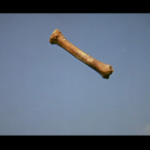by Seán Hudson
We think too fast, while on our way somewhere, while walking or in the midst of all sorts of business, even when thinking of the most serious things; we need little preparation, not even much silence: it is as if we carried around in our heads an unstoppable machine that keeps working even under the most unfavourable circumstances. Formerly, one could tell just by looking at a person that he wanted to think – it was probably a rare occurrence! – , that he now wanted to become wiser and was preparing himself for a thought: one would set one’s face as for prayer and stop walking; yes, one stood still for hours on the street once the thought ‘arrived’ – on one or two legs. (Nietzsche 2003: 33-34)
Things happen and we put them into boxes – I think that might be an accurate way of describing the general human relation with experience. It’s very practical, of course; we wouldn’t get far in life, that chaotic whirl of sensations, without organising it into categories, like the self, or race, or gender, etc. No one can deny that humans are expert labellers. But then, conversely, we’ve also developed ways of bypassing our filters: of abandoning our boxes and indulging in their contents. Film has the potential to be one of these tools, to short-circuit cognition in the wake of the primacy of affect.
What does that mean, exactly? I like to think that it’s connected to the peculiar experience I had the other day, sitting outside a café, disoriented, sleep-deprived, and hung-over. I looked up and saw two giant red circles, white within the diametre, each bisected by a thick, blue line. The redness was particularly vivid. It took me a moment or two to realise that I was looking at signs for the London Underground. On a normal day, the red circles would not have appeared to me as red circles: they would have been familiar signs. From the image, my cognition would leap to the appropriate associations with trains, transport, etc. However, in a state where my body was shutting down in various ways (taking a bite out of my sandwich induced a flood of inexplicable tears, for example), my perception was altered, the unconscious work of interpreting signs suspended. I didn’t see the image primarily as the signified, but as a direct, concrete, non-representational event. I believe this is similar to what Barthes meant when he defined the pleasure of the text as ‘value shifted to the sumptuous rank of the signifier’ (1975: 65).
Films are especially good at making signs lose their power to signify. Deleuze believes that one of the key attributes of cinema is its ability to create a non-human perspective with which viewers can engage: the eye of the camera may free us from our own, human perception of events. No longer seeing images as representations of our own, limited world, we are more susceptible to the immediacy of sensation – this is perhaps true of all art, even non-visual art. However, the cinematic power of film is its presentation of a material image (unlike the images of literature which require the exercise of the imagination) from a viewpoint that denies my judgement, whether cognitive or imaginative. When I saw the Tube signs as red circles, I was seeing as though I wasn’t a categorising machine, as though I were watching a film.
Something similar happens in certain kinds of meditation: paying attention to immediate, bodily sensations (the flow of breath, the feeling of clothes against skin, etc.) serves to neutralise the pre-established categorisations that usually inform our experience, such as the idea of a mind, or a self. These ideas reveal themselves as abstractions derived from sensations. More importantly, returning to sensation inspires new thought. We tend to conceive of thoughts as belonging to a pre-existing consciousness, whereas in fact, if we listen to Hume, it’s the other way around: thoughts and sensations are what ground a consciousness, and what we call the ‘self’. Where, then, do these thoughts come from? Deleuze believes they spring from the interaction between humans and the world, that they are the violent offspring of this union. What this implies is that thinking comes from outside of us, not from within. The sort of thinking in which we consciously reflect on a film that we’re watching is obviously not what Deleuze is referring to; rather, it is the shock of thought that denies consciousness (a categorising and categorised self), and by doing so paradoxically gives rise to consciousness (new thought). As Richard Rushton puts it, ‘one cannot really be thinking if one knows what one is thinking’ (2012: 107, italics in the original). Cinema is not just about allowing us to see the world as though it were fresh (defamiliarisation, the purpose of all art according to Viktor Shklovsky). It’s about the shock of new thought that comes with the breakdown of our imagined status as unified, stable subjects.

My personal favourite example is from Tran Anh Hung’s Norwegian Wood (Noruwei no mori, 2010), a film which doesn’t rank anywhere near the top of my all-time favourites list. But there’s a moment near the beginning when we see a character inexplicably and methodically killing himself, filling a carefully sealed car with exhaust fumes as he awaits death – the image cuts to a shot of a spider in close-up, surrounded by brightness, descending on its thread. It goes without saying that scenes will affect viewers differently, but for me, this cut is profound because, unlike, say, Kubrick’s famous graphic match between the hurled bone and the spaceship in 2001: A Space Odyssey (1968), the sense of wonder that this cut instils does not come accompanied with a judgement, such as the narrative unification brought about by

presenting man’s ancient ancestors as alligned with his future descendants in space – not unity, but a jarring disunity. There is no obvious link between the image of the boy in the car and the descending spider, nothing about the film pushes us towards the interpretation that the spider is a metaphor for death, for instance. And yet there is something beautiful about this cut, both on a formal level, and as a way of releasing the tension that mounts from watching the preceding suicide. For me, what is wonderful is the gap, or the unseeable edge between one image and the other, and the image of the spider, as it is the second

image, embodies that wonder. It is against that edge that the self disintegrates; all categorisations fail in the eruption of new thought.
One may suggest that if knowledge of the boy’s suicide informs the experience of “new thought” that the sudden appearance of the spider elicits, then surely it is consciousness, and the ability to categorise these images into something meaningful, that grounds this? It’s a fair point, as some kind of categorisation must take place before I can see the lines and colours on the screen as a boy, a car, a spider, etc. But it is also true that (in my case at least) the cinematic movement between images is what shatters these categorisations to the extent that the lines and colours seem to me the source of thought, even if I identify the representation of a spider

as a spider itself, the artfulness of the cut brings me back to the vividness of the image as an image; a pure signifier. There’s an image from Sunshine (2007) that I find similarly striking though far more reliant on narrative context. Silhouetted against a transparent wall, the botanist’s body contorts as huge waves of fire destroy the oxygen garden that she has been cultivating on the other side of the wall. Here there is a clear sensory loop between image and thought. From the immediacy of the fiery image my mind falls back on various contextual resources: the film’s theme of man vs. the sun (as immense, flaming star and as sublime, spiritual experience), the empathy-inducing knowledge

derived from narrative context that the woman is in deep despair, Christian imagery of suffering in Hell… All of this contextual information lends power to the image as a loop between affect and cognition emerges, which in turn generates its own affect. So I make no claim that the power of cinema is one that functions beyond the realm of human cognition; rather, it engages it, exercises it, and (in a film’s best moments) overwhelms it entirely.
In view of all this, my belief is that cinema’s greatest achievement is its ability to disturb us. I don’t mean in the sense that it leaves us feeling uneasy, but in the sense that it disturbs categorisations that we take for granted; it reveals them as illusory, it provides a sensory rebuttal of Descartes’s assertion that being becomes evident in light of consciousness (“I think therefore I am”) by diminishing both terms in light of the image; being and consciousness are abstract and constructed categorisations of experience, results of the human tendency to find ways of identifying “me” in all of these images, whereas film can return us to the images themselves. While Descartes believed that we could abstract the existence of the world from our conception of a self, film shows us that the reverse is true: from the world, we abstract a conception of the self. In the manipulation of images, film has the power to profoundly disturb the relationship between Self and Other that we impose on all existence, a power which has political as well as philosophical potential.
I will end by returning to Barthes, as his meditation on cultural texts strikes me as particularly relevant here:
Text means Tissue; but whereas hitherto we have always taken this tissue as a product, a ready-made veil, behind which lies, more or less hidden, meaning (truth), we are now emphasising, in the tissue, the generative idea that the text is made, is worked out in a perpetual interweaving; lost in this tissue – this texture – the subject unmakes himself, like a spider dissolving in the constructive secretions of its web. Were we fond of neologisms, we might define the theory of the text as an hyphology (hyphos is the tissue and the spider’s web). (Barthes 1975: 64)
Works cited
Deleuze, Gilles. (2005) Cinema I: The Movement-Image. London: Continuum.
Barthes, Roland. (1975) The Pleasure of the Text. Trans. Richard Miller. New York: Farrar, Straus and Giroux.
Nietzsche, Friedrich. (2003) The Gay Science. Trans. Josefine Nauckhoff, Adrian Del Caro. Ed. Bernard Williams. Cambridge: Cambridge University Press.
Rushton, Richard. (2012) Cinema After Deleuze. London: Continuum.